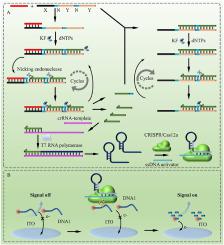当前位置:
X-MOL 学术
›
Anal. Chim. Acta
›
论文详情
Our official English website, www.x-mol.net, welcomes your feedback! (Note: you will need to create a separate account there.)
Application of CRISPR/Cas12a in miRNA-155 detection: A novel homogeneous electrochemiluminescence biosensor
Analytica Chimica Acta ( IF 5.7 ) Pub Date : 2024-06-07 , DOI: 10.1016/j.aca.2024.342843 Yuanxun Gong , Hongyu Zeng , Sisi Gao , Yanlin He , Jie Wang , Jihua Wei , Qianli Tang , Kai Zhang , Xianjiu Liao
Analytica Chimica Acta ( IF 5.7 ) Pub Date : 2024-06-07 , DOI: 10.1016/j.aca.2024.342843 Yuanxun Gong , Hongyu Zeng , Sisi Gao , Yanlin He , Jie Wang , Jihua Wei , Qianli Tang , Kai Zhang , Xianjiu Liao

|
MicroRNAs (miRNAs) are important non-coding RNA entities that affect gene expression and function by binding to target mRNAs, leading to degradation of the mRNAs or inhibiting their translation. MiRNAs are widely involved in a variety of biological processes, such as cell differentiation, development, metabolism, and apoptosis. In addition, miRNAs are associated with many diseases, including cancer. We have developed an innovative homogeneous electrochemiluminescence (ECL) biosensor. This biosensor employs CRISPR/Cas12a gene editing technology for accurate and efficient detection of microRNA (miRNA). Compared to conventional technologies, this biosensor employs a unique homogeneous detection format that eliminates laborious probe fixation steps and greatly simplifies the detection process. By using two amplification techniques - isothermal amplification and T7 RNA polymerase amplification - the biosensor improves the sensitivity and specificity of the assay, providing excellent detection performance in the assay. This makes it possible to evaluate miRNA directly from a variety of biological samples such as cell lysates and diluted human serum. Experimental results convincingly demonstrate the extraordinary performance of this biosensor, including its extremely low detection limit of 1.27 aM, high sensitivity, reproducibility and stability. The application of our constructed sensor in distinguishing between cancerous and non-cancerous cell lines highlights its potential for early cancer detection and monitoring. This innovative approach represents a major advancement in the field of miRNA detection, providing a user-friendly, cost-effective, and sensitive solution with broad implications for clinical diagnosis and patient care, especially in point-of-care settings.
中文翻译:

CRISPR/Cas12a在miRNA-155检测中的应用:一种新型均相电化学发光生物传感器
MicroRNA (miRNA) 是重要的非编码 RNA 实体,通过与目标 mRNA 结合,导致 mRNA 降解或抑制其翻译,从而影响基因表达和功能。 miRNA广泛参与细胞分化、发育、代谢、凋亡等多种生物过程。此外,miRNA 与许多疾病相关,包括癌症。我们开发了一种创新的均相电化学发光 (ECL) 生物传感器。该生物传感器采用 CRISPR/Cas12a 基因编辑技术,可准确、高效地检测 microRNA (miRNA)。与传统技术相比,该生物传感器采用独特的均质检测形式,消除了繁琐的探针固定步骤,大大简化了检测过程。通过使用两种扩增技术 - 等温扩增和 T7 RNA 聚合酶扩增 - 生物传感器提高了测定的灵敏度和特异性,在测定中提供出色的检测性能。这使得直接评估各种生物样品(例如细胞裂解物和稀释的人血清)中的 miRNA 成为可能。实验结果令人信服地证明了该生物传感器的非凡性能,包括1.27 aM的极低检测限、高灵敏度、重现性和稳定性。我们构建的传感器在区分癌细胞系和非癌细胞系方面的应用凸显了其早期癌症检测和监测的潜力。这种创新方法代表了 miRNA 检测领域的重大进步,提供了一种用户友好、经济有效且灵敏的解决方案,对临床诊断和患者护理(尤其是在护理点环境中)具有广泛的影响。
更新日期:2024-06-07
中文翻译:

CRISPR/Cas12a在miRNA-155检测中的应用:一种新型均相电化学发光生物传感器
MicroRNA (miRNA) 是重要的非编码 RNA 实体,通过与目标 mRNA 结合,导致 mRNA 降解或抑制其翻译,从而影响基因表达和功能。 miRNA广泛参与细胞分化、发育、代谢、凋亡等多种生物过程。此外,miRNA 与许多疾病相关,包括癌症。我们开发了一种创新的均相电化学发光 (ECL) 生物传感器。该生物传感器采用 CRISPR/Cas12a 基因编辑技术,可准确、高效地检测 microRNA (miRNA)。与传统技术相比,该生物传感器采用独特的均质检测形式,消除了繁琐的探针固定步骤,大大简化了检测过程。通过使用两种扩增技术 - 等温扩增和 T7 RNA 聚合酶扩增 - 生物传感器提高了测定的灵敏度和特异性,在测定中提供出色的检测性能。这使得直接评估各种生物样品(例如细胞裂解物和稀释的人血清)中的 miRNA 成为可能。实验结果令人信服地证明了该生物传感器的非凡性能,包括1.27 aM的极低检测限、高灵敏度、重现性和稳定性。我们构建的传感器在区分癌细胞系和非癌细胞系方面的应用凸显了其早期癌症检测和监测的潜力。这种创新方法代表了 miRNA 检测领域的重大进步,提供了一种用户友好、经济有效且灵敏的解决方案,对临床诊断和患者护理(尤其是在护理点环境中)具有广泛的影响。






































 京公网安备 11010802027423号
京公网安备 11010802027423号